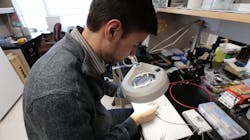Fiber Optics/Microscopy: Miniature microscope enables deep brain exploration
A tiny, laser-scanning microscope designed to peer deep into a living brain is the product of neuroscientists and bioengineers at the University of Colorado Anschutz Medical Campus.1 Microscopes commonly used for brain research penetrate only about 1 mm, "but almost everything we want to see is deeper than that," said Prof. Diego Restrepo, Ph.D., director of the Center for NeuroScience.
Measuring about half an inch in diameter, the unit can be mounted directly onto the head of a mouse. A thin, fiber-optic cord will allow the animal to freely roam while scientists look inside its brain and monitor reactions to stimuli. That means brain structures such as the amygdala, which had been virtually off-limits to microscopes, will soon be seen in real time, high resolution, and 3D.
The microscope's electrowetting lens is faster and less sensitive to motion than other small, focusing lenses. It allows rapid shifting of focus by applying electricity across two different liquids, which actually changes the curvature of lens. "You can manipulate this lens while most others are fixed. That means you can see neurons firing inside a living brain," said Restrepo.
"Using optical methods to stimulate and record from neurons is the future of neuroscience research," said Baris Ozbay, a doctoral student in bioengineering and lead author of the paper. "Most researchers are adapting existing large microscopes to fit mice for head-fixed imaging, which limits movement, is difficult to set up, and has issues with motion. The solution is to put the microscope on the mouse, rather than putting the mouse on the microscope."
"We can now measure a large region and sample more neurons," said assistant professor Emily Gibson, Ph.D. "For example, we can image up to 100 neurons at the same time, as opposed to perhaps the 10 or so we could do in the past."
The work promises to facilitate the understanding of human brain disease and formulation of new treatments.
1. E. Gibson et al., "Miniaturized fiber-coupled confocal fluorescence microscope with an electrowetting variable focus lens using no moving parts," Opt. Lett., doc. ID 236814 (posted Apr. 30, 2015; in press).
About the Author

Barbara Gefvert
Editor-in-Chief, BioOptics World (2008-2020)
Barbara G. Gefvert has been a science and technology editor and writer since 1987, and served as editor in chief on multiple publications, including Sensors magazine for nearly a decade.
